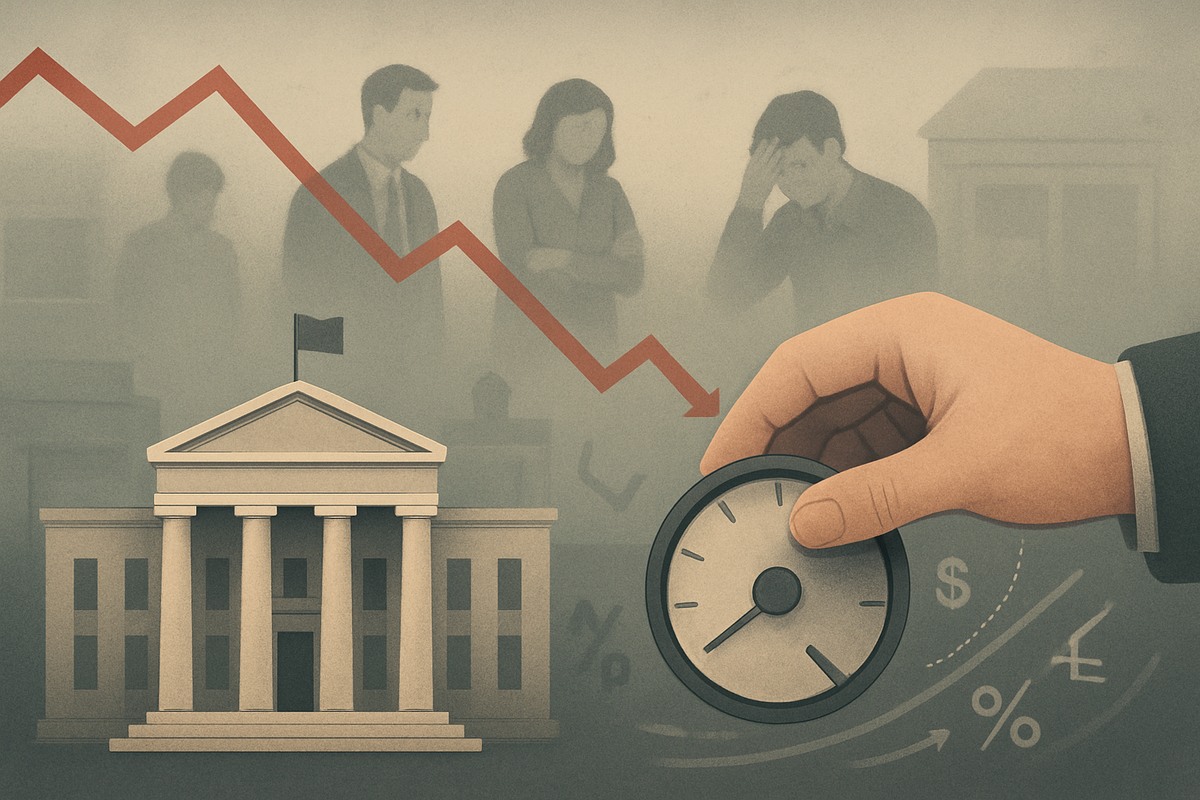
The United States is currently witnessing a significant cooling in its job market, a trend that has prompted the Federal Reserve to implement successive interest rate cuts in recent months. As of November 17, 2025, the central bank's dual mandate—to foster maximum employment and maintain price stability—is heavily leaning towards bolstering a labor market showing clear signs of deceleration and increased vulnerability. This shift in policy marks a critical juncture for the US economy, signaling the Fed's proactive approach to avert a deeper downturn, even as inflation remains a persistent, albeit elevated, concern.
The immediate implication of these rate cuts is a potential easing of borrowing costs for consumers and businesses, designed to stimulate economic activity and encourage hiring. However, the move also underscores growing anxieties among policymakers regarding the sustainability of current employment levels, setting the stage for a period of careful economic rebalancing. Market participants are closely watching for further signals from the Federal Open Market Committee (FOMC) on the trajectory of future rate adjustments and their broader impact on various sectors.
The Unfolding Narrative: A Softening Labor Market and the Fed's Response
The US job market has undergone a notable transformation throughout 2025, moving from robust growth to a state of pronounced moderation. This deceleration has been a primary driver behind the Federal Reserve's recent monetary policy adjustments.
Specific details highlight the extent of this shift: Year-over-year payroll growth in October 2025 plummeted to a mere 0.5%, a stark contrast to the 1.7% observed at the beginning of the year. The Automatic Data Processing (ADP) National Employment Report for October 2025 revealed a modest increase of only 42,000 private sector jobs, following two consecutive months of declines. The average monthly job additions over the preceding three months have fallen to a meager 29,300, indicating a significant slowdown in job creation. Concurrently, the unemployment rate has been on an upward trajectory, rising to 4.3% in August 2025 from 4.2% in July, with projections suggesting it could reach 4.5% by year-end.
The timeline of events leading up to this moment underscores the Fed's responsiveness. In September 2025, the Federal Reserve cut interest rates by 25 basis points, citing a softer-than-expected August jobs report and increasing downside risks to employment. This was followed by another 25-basis-point rate cut in October 2025, bringing the federal funds rate target range to 3.75% to 4.00%. Federal Reserve Chair Jerome Powell characterized the September cut as a "risk management cut," aimed at preempting a more severe slowdown in the labor market. The surge in layoffs has been particularly alarming, with 153,000 job cuts announced in September 2025, contributing to approximately 1 million job cuts so far in 2025—a 65% increase from the previous year. October 2025 recorded one of the worst monthly layoff totals in over two decades, further solidifying concerns about weakening job security and consumer confidence.
Key players involved include the Federal Reserve's FOMC, which is responsible for setting monetary policy, and various government agencies like the Bureau of Labor Statistics (BLS), whose official data, though recently delayed by a federal government shutdown, remains crucial for policy decisions. Private sector reports from entities like ADP have filled some of the data gaps. Initial market reactions to the rate cuts have been been mixed, with some sectors welcoming the prospect of lower borrowing costs, while others remain cautious, fearing that the cuts signify a deeper underlying economic malaise. The bond market, in particular, has seen fluctuations as investors adjust to the new interest rate environment, and equity markets are closely scrutinizing corporate earnings reports for signs of economic resilience or weakness.
Corporate Impact: Winners and Losers in a Shifting Landscape
A weakening job market and subsequent Fed rate cuts create a ripple effect across various industries, producing both beneficiaries and those facing headwinds. Understanding these dynamics is crucial for investors and businesses navigating the evolving economic climate.
Potential Winners: Sectors that are typically sensitive to interest rates and consumer spending are likely to benefit from lower borrowing costs. Housing and Real Estate companies, such as homebuilders like D.R. Horton (NYSE: DHI) and Lennar Corporation (NYSE: LEN), could see increased demand as mortgage rates decline, making homeownership more affordable. Similarly, real estate investment trusts (REITs) might experience a boost. Automotive manufacturers like General Motors (NYSE: GM) and Ford Motor Company (NYSE: F) could see improved sales as auto loan rates become more attractive, encouraging consumers to purchase new vehicles. Retailers that rely on consumer discretionary spending, such as Amazon (NASDAQ: AMZN) and Walmart (NYSE: WMT), might also see a modest uptick in sales if lower interest rates translate into greater disposable income for households, though a weakening job market could counteract this benefit. High-growth technology companies often rely on financing for expansion, and lower interest rates can reduce their cost of capital, potentially boosting valuations for firms like Microsoft (NASDAQ: MSFT) and Alphabet (NASDAQ: GOOGL). Companies with significant debt burdens, irrespective of sector, could also benefit from lower interest payments, improving their financial health.
Potential Losers: Conversely, some sectors may face challenges. Financial institutions, particularly banks like JPMorgan Chase (NYSE: JPM) and Bank of America (NYSE: BAC), often see their net interest margins (the difference between what they earn on loans and pay on deposits) squeezed in a low-interest-rate environment. A weakening job market also increases the risk of loan defaults, further impacting their profitability. Companies in the recruitment and staffing industry, such as Robert Half International (NYSE: RHI) and ManpowerGroup (NYSE: MAN), are directly exposed to a slowdown in hiring and increased layoffs, which will negatively affect their business volumes. Luxury goods manufacturers and high-end service providers might also experience a downturn as consumer confidence wanes and households become more cautious with discretionary spending due to job market uncertainties. Furthermore, companies with strong cash positions that rely on higher interest rates for investment income might see reduced returns on their liquid assets.
The overall impact on companies will depend on their specific business models, debt levels, and sensitivity to consumer spending and interest rate fluctuations. While lower rates aim to stimulate the economy, a truly weakening job market could overshadow these benefits, leading to a more cautious approach from both businesses and consumers.
Wider Significance: A Broader Economic Context
The current weakening of the US job market and the Federal Reserve's responsive rate cuts are not isolated events but rather integral components of broader economic trends and have significant implications for various stakeholders. This scenario fits into a larger narrative of economic cycles, global pressures, and evolving monetary policy strategies.
This event fits into broader industry trends marked by a post-pandemic recalibration of labor markets and persistent inflationary pressures. While the initial years following the pandemic saw unprecedented job growth and wage increases, the current slowdown suggests a return to more normalized, albeit more challenging, conditions. The Fed's actions reflect a global trend where central banks are grappling with the delicate balance of taming inflation while preventing a recession. Potential ripple effects on competitors and partners are substantial. For instance, a slowdown in US consumer spending due to job market weakness could impact international trade partners and global supply chains, affecting companies that rely heavily on the American market. Domestically, businesses that supply the housing or automotive sectors might experience reduced demand, creating a domino effect across interconnected industries.
Regulatory or policy implications are also significant. The Fed's decisions are closely watched by other regulatory bodies, and a prolonged period of economic uncertainty or a more severe downturn could prompt calls for fiscal stimulus measures from Congress. There might also be increased scrutiny on labor market policies and unemployment benefits to support affected workers. Historically, the Fed has cut rates in response to weakening employment data during periods like the early 2000s dot-com bust or the 2008 financial crisis. Comparisons to these events highlight the Fed's commitment to its employment mandate, but also underscore the complexity of the current situation, where inflation remains above target—a factor less prominent in some past easing cycles. This dual challenge presents a unique dilemma for policymakers, who must weigh the risks of reigniting inflation against the imperative of supporting the labor market. The delayed release of official economic data due to a recent federal government shutdown further complicates this, creating a "fog" of uncertainty that makes precise policy calibration more challenging.
What Comes Next: Navigating the Economic Crossroads
The path forward for the US economy, shaped by a weakening job market and the Federal Reserve's recent rate cuts, presents a complex interplay of short-term adjustments and long-term strategic considerations. Stakeholders across all sectors must prepare for a range of potential scenarios and adapt to emerging opportunities and challenges.
In the short-term, we are likely to see continued volatility in financial markets as investors digest new economic data and Fed communications. Further rate cuts in December 2025 are not a foregone conclusion, given internal divisions within the FOMC regarding the balance between employment and inflation goals. Businesses may adopt a more cautious approach to hiring and investment, potentially leading to a further slowdown in job growth. Consumers, facing job insecurity and higher continuing claims for unemployment benefits, may become more conservative in their spending, impacting retail and service industries. Companies will need to focus on optimizing operational efficiency and managing cash flow to weather potential economic headwinds.
Looking at long-term possibilities, if the Fed's rate cuts successfully stimulate demand without reigniting inflation, the economy could achieve a "soft landing," where the job market stabilizes, and growth resumes at a sustainable pace. However, a less favorable scenario could see the economy tip into a mild recession if job losses accelerate and consumer spending contracts significantly. This would necessitate more aggressive monetary and potentially fiscal interventions. Potential strategic pivots for businesses include diversifying revenue streams, enhancing technological adoption to improve productivity, and strengthening supply chain resilience. Companies heavily reliant on debt might prioritize deleveraging, while those with strong balance sheets could look for opportunistic acquisitions.
Market opportunities may emerge in defensive sectors such as utilities, consumer staples, and healthcare, which tend to be more resilient during economic downturns. Additionally, companies focused on automation, AI, and efficiency-enhancing technologies could see increased demand as businesses seek to cut costs. Challenges include sustained pressure on corporate earnings, increased credit risk, and heightened competition in a slower growth environment. Investors should closely monitor key economic indicators like unemployment rates, inflation figures (CPI and PCE), and corporate earnings reports for insights into the economy's direction. The Fed's forward guidance and the minutes from FOMC meetings will also provide crucial clues about future monetary policy.
Comprehensive Wrap-up: Assessing the Market's Trajectory
The weakening US job market, punctuated by decelerating job growth and a surge in layoffs, has undeniably become the central driver behind the Federal Reserve's recent interest rate cuts. As of November 17, 2025, the Fed's proactive stance reflects a critical effort to fulfill its dual mandate, prioritizing maximum employment in the face of persistent, albeit elevated, inflation.
Key takeaways from this evolving situation include the significant slowdown in job creation, with monthly additions plummeting and the unemployment rate steadily climbing. The Fed has responded with two 25-basis-point rate cuts in September and October 2025, bringing the federal funds rate to 3.75%-4.00%, signaling its commitment to supporting the labor market. While these cuts aim to stimulate economic activity by lowering borrowing costs, their effectiveness will be tested against the backdrop of waning consumer confidence and ongoing inflationary pressures. The corporate landscape will see a divergence, with interest-rate-sensitive sectors like housing and technology potentially benefiting, while financial institutions and staffing companies may face headwinds.
Moving forward, the market remains in a state of cautious optimism mixed with apprehension. The assessment of the market will largely depend on whether the Fed can engineer a "soft landing"—stabilizing the job market without triggering a resurgence of inflation or pushing the economy into a deep recession. The internal divisions within the FOMC, combined with the delayed release of official economic data, add layers of uncertainty to future policy decisions.
Final thoughts on significance and lasting impact suggest that this period could redefine the Fed's response mechanisms in a complex economic environment where both employment and inflation targets are challenging. It underscores the delicate balancing act required of central bankers and highlights the interconnectedness of global economic factors. The lasting impact could include a more resilient approach to corporate financial planning, a greater emphasis on labor market flexibility, and potentially new fiscal policy discussions aimed at supporting employment.
Investors should watch for several key indicators in the coming months: the pace of future job reports, particularly the non-farm payrolls and unemployment rate; inflation data (CPI and PCE) to gauge price stability; and, crucially, the Fed's forward guidance and the tone of FOMC meeting minutes. Any signs of stabilization in the labor market coupled with a sustained moderation in inflation would be positive, whereas continued deterioration in employment figures or an unexpected spike in inflation could signal further economic turbulence and more aggressive policy responses. The effectiveness of the current rate cuts in reversing the job market's decline will be the ultimate determinant of the economy's trajectory into 2026.
This content is intended for informational purposes only and is not financial advice





